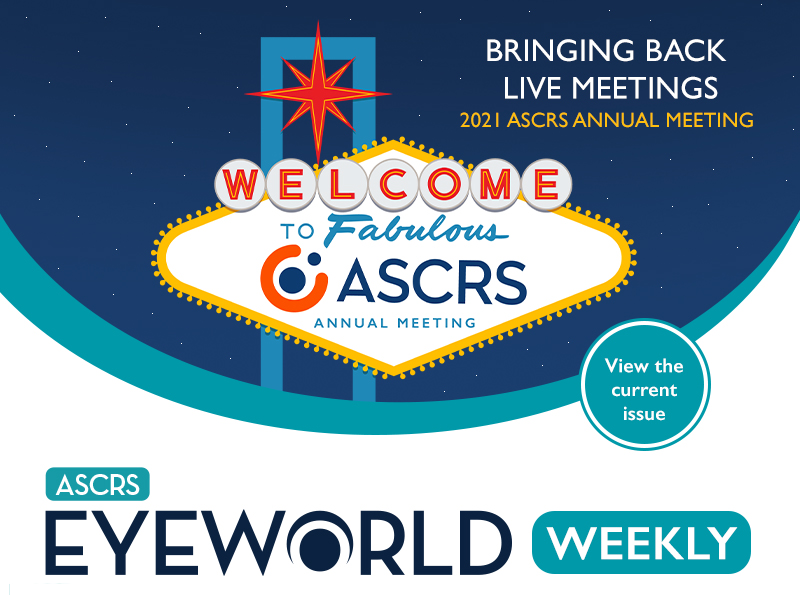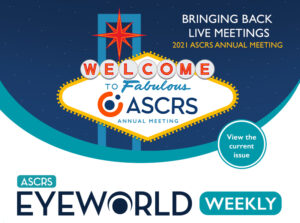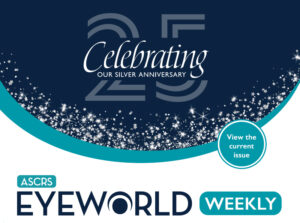
- Positive topline results for Phase 3 trial of drug for allergic conjunctivitis
- Phase 2 trial of progesterone topical gel for DED begins
- Breakthrough Device Designation granted to remote glaucoma management system
- Glaukos enters into licensing agreement for presbyopia treatment
- Increase in laser vision correction procedures continues
- Guide on climate change and eye health
- ASCRS events
April 30, 2021 • Volume 27, Number 17
Positive topline results for Phase 3 trial of drug for allergic conjunctivitis
Aldeyra Therapeutics announced positive topline results from its Phase 3 INVIGORATE clinical trial of 0.25% reproxalap ophthalmic solution for patients with allergic conjunctivitis. According to the company’s press release, the investigational drug achieved statistical significance in its primary endpoint of relieving ocular itch at prespecified timepoints and secondary endpoints of ocular redness, ocular tearing, and total ocular severity score. These results are consistent with prior clinical trials with reproxalap. Reproxalap, according to the press release, is a novel, small-molecule, immune-modulating covalent inhibitor of reactive aldehyde species, which are higher in cases of ocular and systemic inflammatory disease.
Phase 2 trial of progesterone topical gel for DED begins
SIFI has begun patient enrollment for a Phase 2 clinical trial of different concentrations (1% and 0.5%) of its progesterone-based topical gel (Pro-ocular) for treatment of dry eye disease. The ProGIFT trial will enroll about 105 participants among four centers in Italy. According to the company’s press release, a prior Phase 2 trial in the U.S. compared Pro-ocular to placebo, demonstrating tear film production via a neural pathway with no serious adverse events. The Pro-ocular gel is applied twice daily to the forehead, activating a neural pathway that stimulates lacrimal and meibomian gland function, according to the company.
Breakthrough Device Designation granted to remote glaucoma management system
Impandata Ophthalmic Products announced FDA Breakthrough Device Designation for its EYEMATE system, a remote patient monitoring system for management of glaucoma. This system, according to the company’s press release, is clinically validated and allows patients to measure IOP anywhere, any time with information automatically sent to their physician.
Glaukos enters into licensing agreement for presbyopia treatment
Glaukos Corporation entered into an exclusive licensing agreement with Intratus for research, development, manufacturing, and commercialization of Intratus’ non-invasive drug delivery platform (Eyelid Drug Delivery Platform) for presbyopia treatment, as well as other ocular conditions, such as glaucoma and dry eye. According to the company’s press release, the Eyelid Drug Delivery Platform uses cream-based drug formations that are applied on the eyelid for transdermal drug delivery. This delivery method in early human studies demonstrated efficacy and a lack of side effects commonly associated with topical eye drops, the press release noted.
Increase in laser vision correction procedures continues
The Refractive Surgery Council reported that the first quarter of 2021 is continuing the increase in laser vision correction (LVC) procedures, maintaining the rise in interest for LASIK and similar procedures driven by the pandemic in 2020. According to the organization, which establishes procedure volume based on reported data from technologies used by the industry’s manufacturers, there was a nearly 30% rise in LVC procedures year over year, with more than 220,000 LASIK, SMILE, and PRK procedures performed so far this year.
Guide on climate change and eye health
The International Association for Prevention of Blindness declared a climate emergency, with its Climate Action Working Group issuing a Call to Action and Guide for Environmentally Sustainable Practices in the Eye Health Sector.
ASCRS events
- ASCRS Grand Rounds with Bascom Palmer Eye Institute is now available online.
- The latest episode of the Ophthalmology Quicksand Chronicles podcast with guest Ashvin Agarwal, MD, is available online.
- The Challenging Cases in Cataract Surgery Symposium at the 2021 ASCRS Annual Meeting is accepting video submissions until May 31.
- Early bird registration for the 2021 ASCRS Annual Meeting ends today, April 30.
Research highlights
- A pilot study published in the journal Clinical Ophthalmology looked at ways to improve patient-clinician collaboration for glaucoma care. The observational study involved nine glaucoma clinicians and 37 patients who were recorded during consultations. Video was assessed for degree of collaboration between clinicians and patients, with patients also completing a Patient Experience Questionnaire and a survey designed to collect information about perceived involvement in their care decisions. The interactions were determined to be “clinician centered” with physicians speaking for the majority (58%) of the consultation and asking the most questions (mean 8.1 questions vs. 2.6 questions from the patient). According to the study, 80% of patients were happy with their involvement in care decisions, but 44% said they’d like to be more involved and 47% said they’d like written information or information sessions on how to be more involved. These findings, the study authors wrote, support future studies looking at interventions that could improve clinician-patient collaboration to further improve patient care in glaucoma management.
- A study published in the American Journal of Ophthalmology associated excessive screen use by children with severe meibomian gland atrophy. The study enrolled children 6–17 years old between December 2016–2017. The study ultimately included 24 patients with insignificant meibomian gland atrophy (controls) and 17 patients with severe gland atrophy. A questionnaire assessed dry eye symptoms, electronic screen use, diet, and outdoor time. Patients with severe gland atrophy exhibited dry eye, 29% had corneal neovascularization, 41% BCVA loss, and 14% central corneal neovascularization. None of the controls had dry eye disease. Those in the severe gland atrophy group reported significant daily electronic screen use: 86% 4 or more hours a day and 50% 8 or more hours a day. None of the controls had more than 2 hours a day of screen time.
- A randomized, controlled trial evaluated crosslinking plus standard of care against standard of care alone (spectacle or contact lens correction) in young patients with keratoconus. Sixty participants 10–16 years old with progressive keratoconus were enrolled; 30 were randomized to receive crosslinking and standard of care and 30 standard of care alone (28 in this latter group were available for analysis). Only one eye from each patient was included in the analysis. At 18 months post-randomization, mean K2 was 49.7 D in the crosslinked group and 52.4 D in the standard of care group. Uncorrected and corrected difference in logMAR at 18 months was better in the crosslinked group, the authors reported. Keratoconus progressed in two patients in the crosslinking group compared to 12 in the standard of care group. The authors wrote that quality of life outcomes were similar between the groups. The authors concluded that with this data, crosslinking could be considered as a first-line treatment for progressive keratoconus. The research is published in the journal Ophthalmology.
Product news
- Hillrom launched the Welch Allyn PanOptic Plus Ophthalmoscope and Welch Allyn MacroView Plus Otoscope.
- Oertli Instrumente launched OS 4, a new version of its surgical platform for retina, glaucoma, and cataract surgery.
This issue of EyeWorld Weekly was edited by Stacy Jablonski and Liz Hillman.
EyeWorld Weekly (ISSN 1089-0319), a digital publication of the American Society of Cataract and Refractive Surgery (ASCRS), is published every Friday, distributed by email, and posted live on Friday.
Medical Editors: Eric Donnenfeld, MD, Chief Medical Editor; Rosa Braga-Mele, MD, Cataract Editor; Clara Chan, MD, Cornea Editor; Nathan Radcliffe, MD, Glaucoma Editor; and Vance Thompson, MD, Refractive Editor
For sponsorship opportunities or membership information, contact: ASCRS • 12587 Fair Lakes Circle • Suite 348 • Fairfax, VA 22033 • Phone: 703-591-2220 • Fax: 703-591-0614 • Email: ascrs@ascrs.org
Mention of products or services in EyeWorld Weekly does not constitute an endorsement by ASCRS.
Click here to view our Legal Notice.
Copyright 2021, EyeWorld News Service, a division of ASCRSMedia. All rights reserved.



